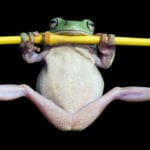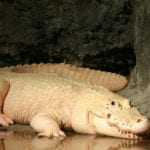 Weird Stuff
Weird Stuff  Weird Stuff
Weird Stuff  Animals
Animals 10 Inspiring Tales of Horses Being Human
 Mysteries
Mysteries Top 10 Haunting Facts About the Ghost Ship MV Alta
 History
History 10 Surprising Stories About the Texas Rangers
 Humans
Humans 10 Philosophers Who Were Driven Mad by Their Own Theories
 Miscellaneous
Miscellaneous 10 Video-Game-Worthy Weapons and Armors from History
 Weird Stuff
Weird Stuff 10 Psychics Who Accurately Predicted Wartime Events
 The Arts
The Arts 10 Pieces of Art Inspired by a Broken Heart
 Health
Health 10 Science Fiction-Sounding New Medical Treatments
 History
History 10 Surprising Facts About the Father of Submarine Warfare
 Weird Stuff
Weird Stuff 10 Times Real Laws Were Based on Bizarre Hypotheticals
 Animals
Animals 10 Inspiring Tales of Horses Being Human
 Mysteries
Mysteries Top 10 Haunting Facts About the Ghost Ship MV Alta
Who's Behind Listverse?

Jamie Frater
Head Editor
Jamie founded Listverse due to an insatiable desire to share fascinating, obscure, and bizarre facts. He has been a guest speaker on numerous national radio and television stations and is a five time published author.
More About Us History
History 10 Surprising Stories About the Texas Rangers
 Humans
Humans 10 Philosophers Who Were Driven Mad by Their Own Theories
 Miscellaneous
Miscellaneous 10 Video-Game-Worthy Weapons and Armors from History
 Weird Stuff
Weird Stuff 10 Psychics Who Accurately Predicted Wartime Events
 The Arts
The Arts 10 Pieces of Art Inspired by a Broken Heart
 Health
Health 10 Science Fiction-Sounding New Medical Treatments
 History
History 10 Surprising Facts About the Father of Submarine Warfare
10 Fantastic And Bizarre Caterpillar Facts
While some people find caterpillars to be cute, adorable little creatures, others are utterly terrified of them. However, few people know how truly fascinating and bizarre the world of the humble caterpillar really is.
From toxic nicotine breath, to butt communication, to one of the most incredible transformation processes in the animal kingdom, there is a lot more to these squishy little creatures than meets the eye.
This fascinating list will reveal unbelievable displays of mind control, a previously unknown form of locomotion, ants drugged into submission, and even a Donald Trump look-alike.
10Portable Suit of Armor

The recently discovered hermit crab caterpillar from Peru exhibits a behavior that, as far as anyone can tell, has never been previously seen in caterpillars before. The caterpillar makes its own little suit of armor (kind of like a portable protective cage) out of leaves which it rolls into a small tube and glues together using its sticky spit. The caterpillar then lies inside this tube and drags itself around the forest floor using its mouth, pulling its leafy coverage along behind it.
As the caterpillar forages for food, its body remains protected, encased in its portable cocoon. The clever little fella even leaves a bulge in the center of its protective tube, which allows it room to turn around inside if it needs to make a quick getaway out the back entrance.[1]
9Amazing Camouflage

Caterpillars employ all sorts of bizarre disguises to protect their soft, squishy bodies from all the animals and insects out there that have caterpillar on the menu. Some caterpillars resemble bird droppings, some have colorful splotches on their bodies that look like snake eyes, and some non-toxic caterpillars will mimic the patterns on their toxic counterparts, so predators will be too wary to make a meal of them.
However, there is one species which is unique among all its soft-bodied brethren. This amazing little caterpillar, named the camouflaged looper, disguises itself using bits of petals and other parts plucked from the variety of plants that it eats. The caterpillar decorates itself by sticking pieces of petals and leaves to its back using its silken spit. Then, when its colorful costume begins to wilt, the looper will cast off its old disguise and start the process all over again.[2]
8The Hopping Caterpillar
In the forests of Southern Vietnam, one species of caterpillar wraps itself in leaves which it fashions into a tiny sleeping bag when it prepares to pupate. The caterpillar, called Calindoea trifascialis, then proceeds to hop around the forest floor completely encased in its leafy cocoon, directing itself away from sunlight. To gain momentum for each hop, the caterpillar anchors its anal prolegs to the bottom of its leafy abode and pistons itself backward, hopping away from the direction its head is facing.
The caterpillars hop around like this for up to three days before settling on a final resting place to begin their metamorphosis. When Chris Darling began studying this little yellow caterpillar back in 1998, he and his students noticed that it was secreting a strange liquid. As any sane person would do in such circumstances, he decided to lick the caterpillar to see what would happen. It didn’t taste of much, but his tongue went numb, which according to Darling indicated that the caterpillar was fighting back with a chemical defense. Back in the lab, he discovered just what he had been licking; a mixture of hydrocarbons and hydrogen cyanide, which coats the insect’s torso. The stench of these poisonous chemicals fills the caterpillar’s little homemade sleeping bag, and this smell deters ants and other would-be predators that otherwise might attempt to dine on the caterpillar’s protein-rich body.[3]
7The Mad Hatterpillar
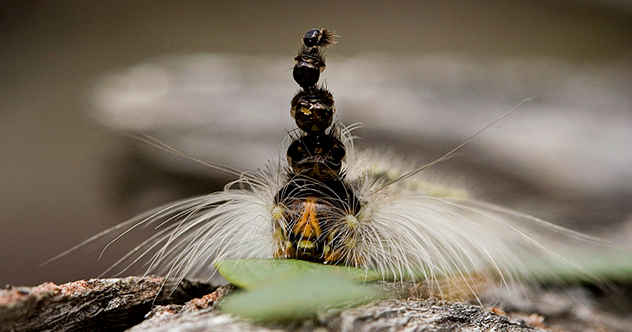
The gum-leaf skeletoniser caterpillar has what looks like a tall, fuzzy horn on top of its head. This strange feature is actually a “hat” made from the old heads the caterpillar sheds every time it molts. Each time it casts off an old skin, the caterpillar pops its most recently shed head capsule on top of its new, bigger head until it has created an impressive little tower.
Each gum-leaf skeletoniser can molt up to thirteen times before its metamorphosis, so their hats can end up towering high over their tiny body. Exactly why the gum-leaf skeletoniser does this is a mystery, but researchers hypothesize that the unique headdress is in some way a defense mechanism, distracting predators into attacking the empty heads instead of the caterpillar. While this seems like a plausible theory, studies revealed that when paired off with a deadly caterpillar-killing insect while confined in the tiny arena of a petri dish, even caterpillars with the tallest crowns fared no better than their hatless comrades. Maybe they just enjoy making and wearing hats![4]
6The Musical Maestros of the Insect World
One species of caterpillar has developed a highly advanced method of communication: They talk to each other with their butts. Scientists at Carlton University in Canada discovered that birch caterpillars have specialized anal “oars” which they drag across leaves to create signals to other caterpillars. This is not the only method of communication in the birch caterpillars’ repertoire; they also shake their bodies and drum and scrape their mandibles along leaf blades to create different signals to other caterpillars in their group. Once one caterpillar starts drumming, shaking, and scraping, other caterpillars will slowly make their way toward their noisy caterpillar friend until a small cluster is formed.
Scientists have not yet worked out what the individual signals actually mean, and some dispute the idea that the caterpillars are communicating with each other at all, but evolutionary biologist Jayne Yack says, “I have been studying insect sounds for more than 30 years, and I’ve never seen an insect species produce such a diversity of signal types.” This is the first evidence that caterpillars may rely on vibrations to form social groups.[5]
5Toxic Nicotine Breath

One of the tobacco hornworm’s favorite foods is the highly toxic leaves of the tobacco plant. The tobacco plant contains nicotine, a toxic poison, which the plant uses as a defense mechanism against animals that otherwise would seek to consume it. Not only can the tobacco hornworm easily consume doses of nicotine that would be deadly to any other animal, the caterpillar also contains a unique gene which allows it to utilize the toxins in nicotine as a defense mechanism.
The caterpillar absorbs nicotine from its gut into its hemolymph, which is the liquid that acts as an insect’s bloodstream. It then opens little pores in its skin called spiracles which release toxic miasmal clouds of the poison. This process is called defensive halitosis (which means defensive bad breath) and, when toxic puffs are aimed at predators like the wolf spider, it prevents the caterpillar from being attacked and eaten.[6]
4Hawaii’s Carnivorous Caterpillars
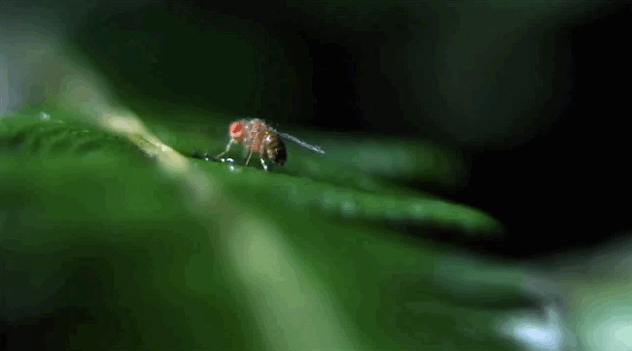
Hawaii is home to a number of carnivorous caterpillars that lie in wait for unsuspecting prey. One species, Hyposmocoma molluscivora, won’t eat plants even if it is starving. This little caterpillar, which is only around eight millimeters long, prefers to dine on snails which it ambushes then slowly eats alive. To prevent the snail from escaping, Hyposmocoma molluscivora attaches its victims to a leaf using silk, in the same way a spider cocoons its prey. The caterpillar then wedges its way into its incapacitated snail-victim’s shell, literally trapping the poor fella in its own home. The caterpillar then proceeds to slowly eat its victim alive until nothing but an empty snail shell is left.[7]
While Hyposmocoma molluscivora is the only species of caterpillar known to eat snails, this little caterpillar is also the first fully amphibious insect to be discovered. Hyposmocoma is just as capable of surviving under water as it is on land, though scientists are baffled as to how it manages to breathe while submerged in water. Daniel Rubinoff, from the University of Hawaii, speculates that the caterpillar may have a specialized breathing organ that has not yet been discovered, or they may have specialized oxygen-diffusing pores in their skin.
Another carnivorous species of caterpillar that makes its home in Hawaii, Eupithecia, looks a bit like a little clawed hand waiting to pounce on unsuspecting prey. These masters of camouflage will perch with their bodies outstretched alongside leaves, resembling a harmless stick, until a hapless victim passes by. In the blink of an eye, Eupithecia will snap its body downward and clasp its prey with elongated, clawed legs before chowing down on its undoubtedly very surprised meal. Hawaii is home to 18 species of carnivorous caterpillar.
3Caterpillar Overlords
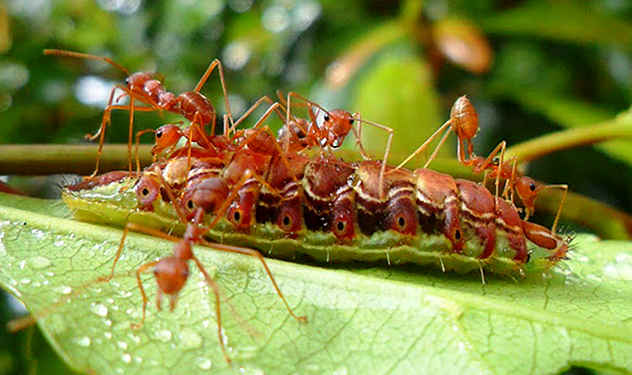
The caterpillars of Japan’s oakblue butterfly have an ingenious defense mechanism which protects them against spiders, wasps, and other insect-predators: They enslave ants, forcing them to become aggressive bodyguards, by using a chemical which the caterpillar secretes in sugary droplets through its skin. The ants are drawn to the scent of this delicious secretion, and once they have consumed it, they will not return to their nest, forage for food, or leave the side of their caterpillar overlord.
The caterpillar also has an attack command: When it inverts its tentacles (the little stalks on top of its head) the caterpillar’s ant minions become extremely aggressive and will attack any nearby insects. Masuru Hojo, from Kobe University in Japan, speculates that glandular cells near the caterpillar’s tentacles could be secreting chemicals which act as a command to its ant slaves. “It is possible that both visual and chemical signals are stimulating the ant aggression,” Hojo said. Ants that have not consumed the droplets do not respond when the caterpillar flips its tentacles, so Hojo believes there must be a chemical in the sweet secretions which manipulates the behavior of the ants that have consumed it.[8]
2Free-Floating Guts and Soft-Bodied Robots

Many readers will be aware that caterpillars crawl in undulating waves, but what is happening inside when they move is unlike anything seen previously in any other animal or insect: Their guts move nearly a full step in advance of the rest of their body. Biologists at Tufts University of Arts and Sciences made this discovery when they x-rayed tobacco hornworm caterpillars to understand more about the way they move.
X-raying a caterpillar is no easy task because caterpillars do not have bones. So, biologist Michael Simon and his team placed their test subjects on a tiny, custom-built caterpillar treadmill and viewed their innards under a special x-ray producing particle accelerator at Argonne National Laboratory in Illinois. What they discovered was that the caterpillar’s guts move independently and in advance of the surrounding body and legs. “Although internal tissue movement caused by locomotion has been identified in many organisms, the caterpillars seemed to be propelling themselves forward by means of a two-body system—the body wall container and the gut it contained. This may contribute to the extraordinary freedom of movement seen in these soft-bodied crawlers,” said Simon, who was the first author of the study published in Current Biology. This unique form of locomotion has been coined visceral locomotive pistoning.
You may be wondering why it’s important for anyone to know what a caterpillar’s guts do when it crawls, but these findings are actually influencing the design and development of soft-bodied robots that may be used in transportation. In July 2010 Michael Simon explained to LiveScience, “One of the big advantages of a soft robot is the ability to move cargo, such as electronics, tools, or chemicals. A robot with a skeleton has a fixed structure, but a soft-bodied robot can deform, both to the outside environment and to the interior contents.”
“There are still opportunities for discovery even in the most humble of places,” Simon said in regards to his teams’ revelations into the way that caterpillars move.[9]
1Caterpillar Soup and Imaginal Disks

Most people are well aware that caterpillars spin cocoons to protect their chrysalis while they go through their metamorphosis. The chrysalis itself, the hardened shell the caterpillar transforms in, actually grows underneath the caterpillar’s last layer of skin. When this skin is shed, the chrysalis is revealed. To begin with, the chrysalis is quite soft, but it hardens up to protect the caterpillar inside as it pupates. And here is where things get fascinatingly bizarre: Now that the caterpillar is encased in a protective shell, it releases digestive enzymes which break down its body into a chunky caterpillar soup. The caterpillar literally dissolves itself, but some very important parts called imaginal disks remain intact.
What is an imaginal disk, you ask? To answer this, we need to travel right back to the beginning of the caterpillar’s life when it was in its tiny egg. As it develops, the unhatched caterpillar grows little clusters of cells (which are the imaginal discs) inside its body. Each disk represents a different part of the body it will eventually have as an adult moth or butterfly; there is a disk for each of its wings, disks for its eyes, its antennae, and so on.
Once the pupating caterpillar has liquefied most of its body, leaving only the imaginal disks floating in ooze, these disks make use of the chunky soup surrounding them to fuel the rapid cell division needed for them to transform into an adult butterfly or moth. The entire transformation process from egg to larvae to adult is called holometabolism.[10]
Though it may seem like things could not get any weirder, researchers later discovered that at least some species of moth can retain memories of lab experiments they endured as caterpillars. Evolutionary ecologist Martha Weiss placed tobacco hornworm caterpillars in a little Y-shaped pipe. One section of the pipe led to an area smelling of ethyl acetate, and the other section led to clean air. The caterpillars that chose the tube leading to the ethyl acetate were then subjected to electric shocks, after which seventy-eight percent of them actively avoided the areas smelling of the chemical. A month later, after the caterpillars had completed their metamorphosis, they were subjected to the same test as adult moths. Seventy-seven percent of the moths actively avoided the pipes smelling of ethyl acetate, which according to Weiss suggests that “parts of the brain are retained that allow memories to persist through this very dramatic transition.”
+Every Caterpillar’s Worst Nightmare

Glyptapanteles is a name that no caterpillar wants to hear, ever. This is the name of a Brazilian parasitoid wasp species that subjects caterpillars to a series of terrifying ordeals that should make us all glad we are not a caterpillar living in Brazil. First, the female Glyptapanteles inserts her stinger-like egg tube into the body cavity of Thyrinteina leucocerae, an unassuming caterpillar that was minding its own business chowing down on leaves. The wasp injects the caterpillar with dozens of tiny eggs which eventually hatch and the baby wasp larvae begin to feed on the insides of the caterpillar as it goes about its day-to-day activities. The caterpillar continues to eat and even sheds three or four skins as its parasitic wasp invaders slowly eat it alive from the inside out.
When the wasp larvae have eaten their fill of the caterpillar’s body, they drill their way through its skin and weave themselves little cocoons in which they will develop into adult wasps. One would think that the caterpillar would die at this point, but instead, for reasons that are not yet entirely understood by science, the caterpillar tirelessly guards the pupating wasps with what is left of its life. The caterpillar does not eat or crawl, it just sits there, sometimes even wrapping itself over the cocooned wasps to protect them. If any insects happen by, the caterpillar will begin to thrash about madly to knock the insects away from the cocoons. When the adult wasps finally emerge, the caterpillar dies.
While scientists are not exactly sure what causes the significant change in the caterpillar’s behavior after its invaders have egressed from its body, they did find that a couple of the larvae always remain behind inside the caterpillar after the rest had tunneled out to pupate. This led researchers to speculate that these remaining larvae may somehow manipulate the caterpillar’s behavior, sacrificing themselves for the greater good of their kin, though this hypothesis needs further investigation.[11]
++Trumpapillar
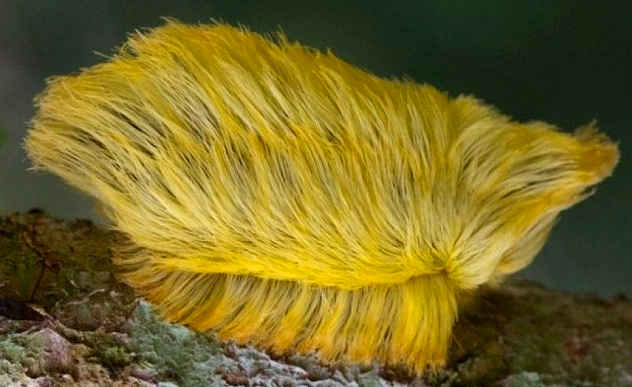
This fuzzy little fella is called the flannel moth caterpillar, but researchers who encountered the critter in the Peruvian Amazon nicknamed it the “Trumpapillar” due to its similarity in color and style to Donald Trump’s hair. These caterpillars actually come in a range of colors, including white, pink, red, and yellow.
The hairs that adorn the caterpillar’s body closely resemble tarantula hairs, and they are covered in little venomous spines which cause an excruciating rash upon contact.[12] This defense method is so successful that, in an example of Batesian mimicry, the chicks of an Amazonian bird called the cinereous mourner look almost exactly like the fuzzy yellow caterpillar. When in danger, the baby bird will even mimic the caterpillar’s movements precisely so as to deter predators such as snakes and monkeys who wish to avoid contact with the venomous Trumpapillar at all costs.
Read more about incredible insects on 10 Surprisingly Human Traits Found In Insects and 10 Insects That Belong in an Alien World.
